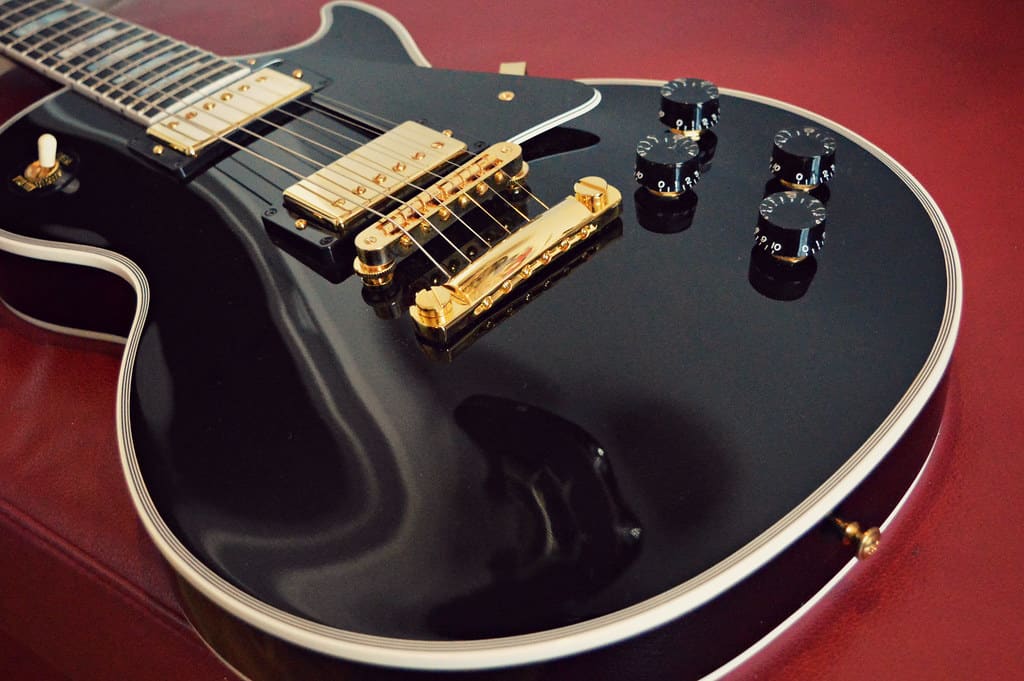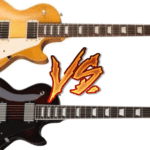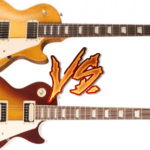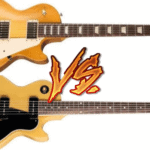Les Paul Customs are the holy grail of the Gibson lineup.
We all want one, although I would argue not many of us know really what they are really about.
What’s so “custom” about them?
Is it how they are made, the materials used, or are there any other quirks to it?
Today, however, I will focus on the question that serves as the title of this article.
Have you noticed most Customs come in solid colors?
It makes it impossible to distinguish if there’s a maple top there.
So, do Les Paul Customs have a Maple Top?
Gibson Les Paul Customs do have and have had maple tops throughout the majority of their existence. However, it is to be noted that the original Customs from the 50s were made completely of mahogany. Some players claim that maple tops have the effect of scooping some mids from their overall tone.
In this article, I will go more in-depth into this question, and tell you all I could figure out about it.
After leaving this page you will be a step further into being an expert in Les Pauls.
So buckle up and Let’s go!
Do all Les Pauls have maple tops?
The problem I usually have with Les Pauls is that there are so many different models.
And not only that, model specs change through the years.
You have to be sort of a guitar historian to answer this question completely, but here’s a summary of the Gibson lineup that satisfied me, at least:
- 50s era Les Paul Customs were made completely of mahogany, with no maple top.
- Modern Les Paul Studios, like many other more “affordable” models, are all mahogany too
- Les Paul Standards all have maple tops, and they can be seen through the transparent finishes
- Modern Les Paul Customs do have maple tops, although it can’t be seen under the solid color paints they usually use on them
And I know, I’m leaving a lot of models out, and even Epiphone, but again, this is just the most basic knowledge you need to have about these guitars.
How to know if a Les Paul has a maple top?
Well, here’s the thing…
If the Les Paul you are interested in has a transparent finish, such as the most famous bursts a Maple top could be easily spotted.
You will notice the heavily patterned figure of the wood, which usually is striped horizontally.
Mahogany has a more compact and smaller grain that looks nothing like it.
For Les Pauls with solid color finishes, the thing gets tricky.
You will necessarily have to look their specs up on the manufacturer’s website or ask around in forums since there’s no practical way of knowing if they have a maple top otherwise.
Do Epiphone Les Paul Customs have maple tops?
Epiphone Les Paul Customs actually don’t come with a maple top.
Some other models from their lineup do use a maple cap, with a thinner more figured veneer on top just for the looks.
How impactful is this? That’s hard to tell, however, if you are wondering that I think you will enjoy my article about how guitar tops affect their tone.
You can read it here:
Do Gibson Les Paul Customs have maple tops?
Gibson Les Paul Customs have had maple tops, at least, since the early 60s.
In the 50s they were made completely of mahogany, which certainly could be something appealing to some players and collectors.
The common confusion about whether these instruments have maple tops or not is fueled by their most common finishes being solid colors.
Also, and as expected, Gibson tends to use the less figured pieces of maple they have in stock for these guitars.
This, however, doesn’t have any effect on their sound and is just a novelty.
What Les Paul models do have maple tops?
The higher-end models come with maple tops, you can name them, Custom, Standard, Traditional, etc.
The rule of thumb is that most, if not all, of the higher-end models of the Gibson lineup, come with maple tops.
Just to name a few, you can think about Les Paul Standards, obviously, Moderns, Traditionals, Customs, any reissues, etc.
And, as I mentioned earlier, the more affordable or student-oriented models like Tributes or Studios are made completely of mahogany, giving them a less luxurious finish.
What are the main differences between a Les Paul Standard and a Les Paul Custom?
So, now that we know that both Les Paul Standards and Les Paul Customs have maple tops, what is that “custom” thing about the latter?
Well, as you might know by now, it will heavily depend on which year’s models we are talking about, but trying to be as general as possible, I can come up with a few usual differences:
| Specifications | Gibson Les Paul Custom | Gibson Les Paul Standard |
| Fingerboard material | Ebony | Rosewood |
| Pickups | 490R, 498T | Burstbuckers |
| Tuners | Kluson tulips | Vintage w/ keystone buttons |
| Hardware | Gold | Nickel |
You will find also differences in their neck profiles, and even construction, and also pickups and specific hardware vary through different models, but again, this is just a broad generalization.
Is the maple top on a Les Paul only a cosmetic feature?
I’m pretty sure the original intention of giving Les Pauls a figured maple top was purely cosmetic.
Gibson positioned their instruments as more of a luxury thing compared to Fender’s more practical and tool-like approach to them.
Over the years, and as guitar snobbism became ubiquitous, some players started noticing (or claiming) that such maple tops actually did something with the tone of the instruments.
Where do I stand with this?
Well, I do think it’s reasonable to believe it does something for the tone. However, how deep is its impact, that’s debatable.
Again, here’s an article in which I debate how do tops affect a guitar’s tone:

Hello there, my name is Ramiro and I’ve been playing guitar for almost 20 years. I’m obsessed with everything gear-related and I thought it might be worth sharing it. From guitars, pedals, amps, and synths to studio gear and production tips, I hope you find what I post here useful, and I’ll try my best to keep it entertaining also.





